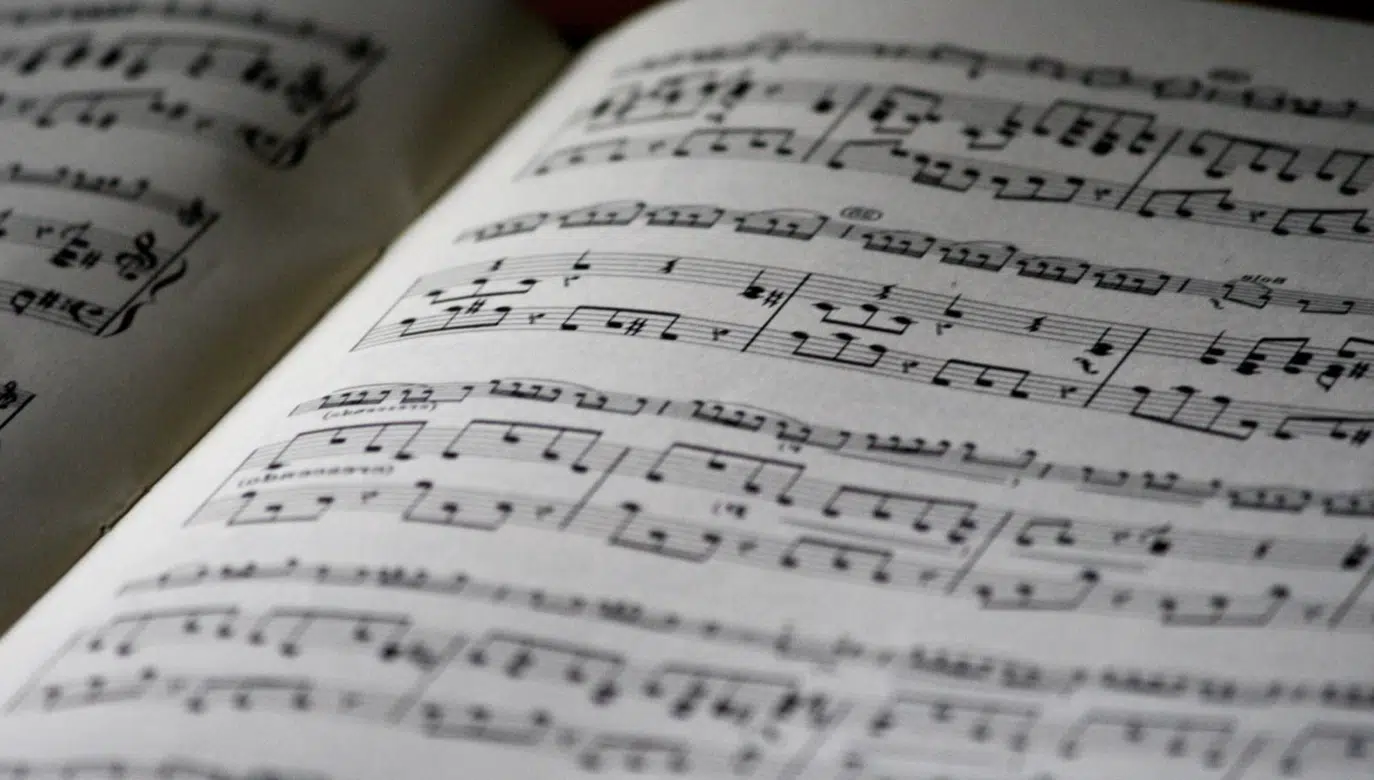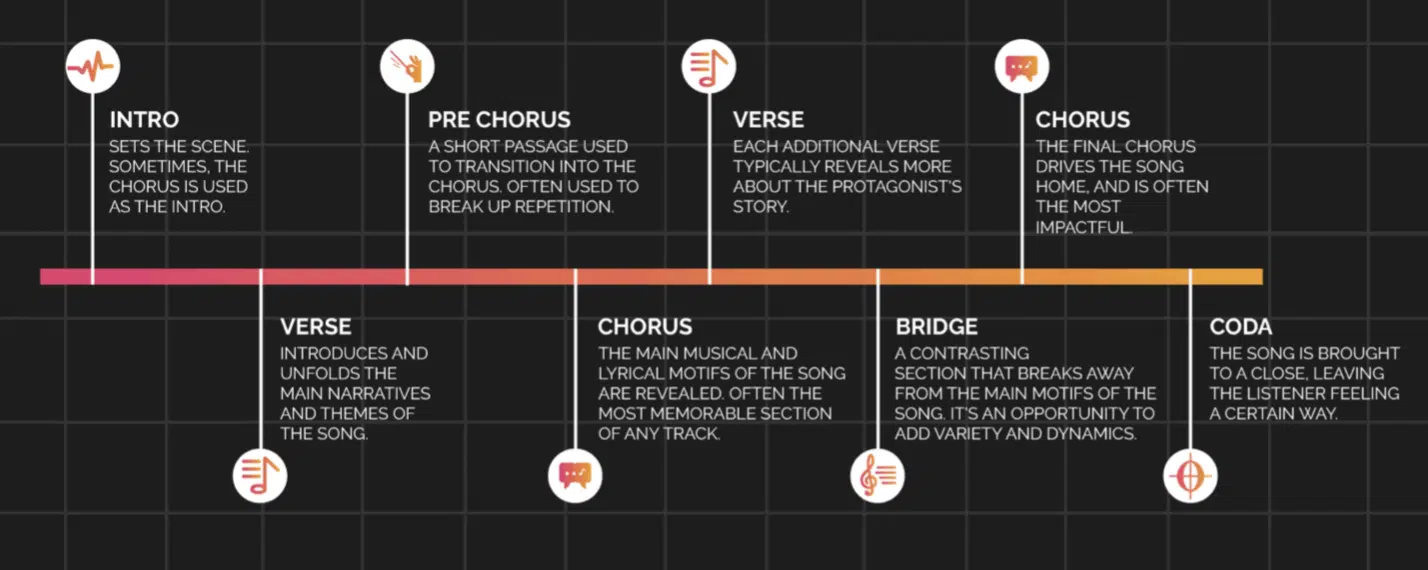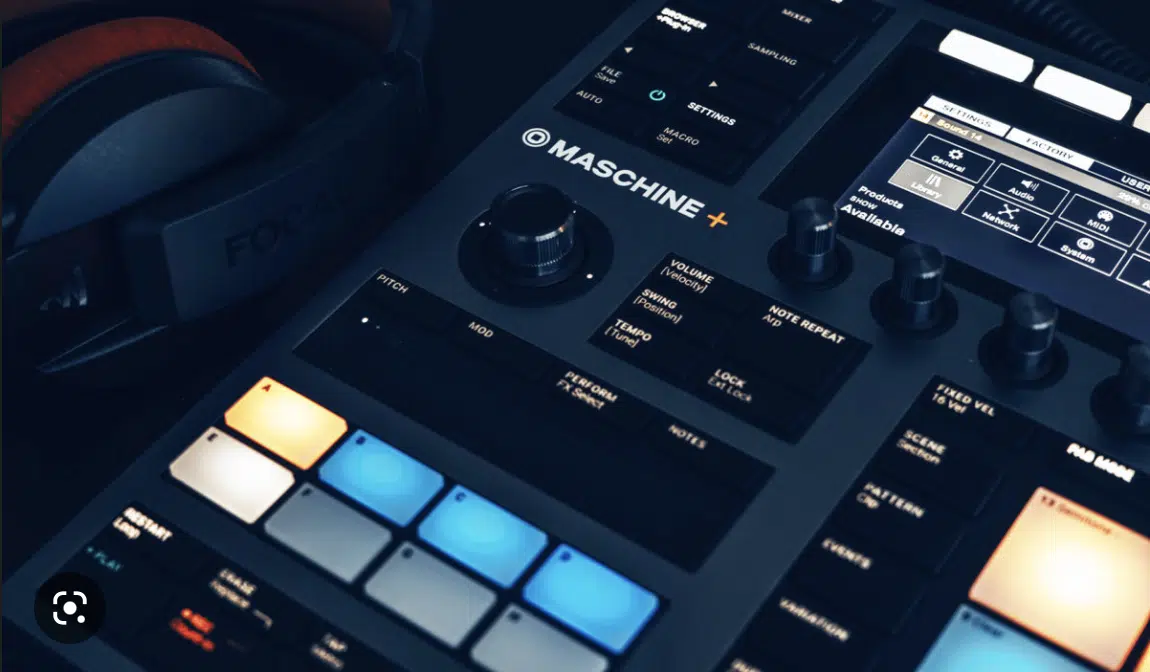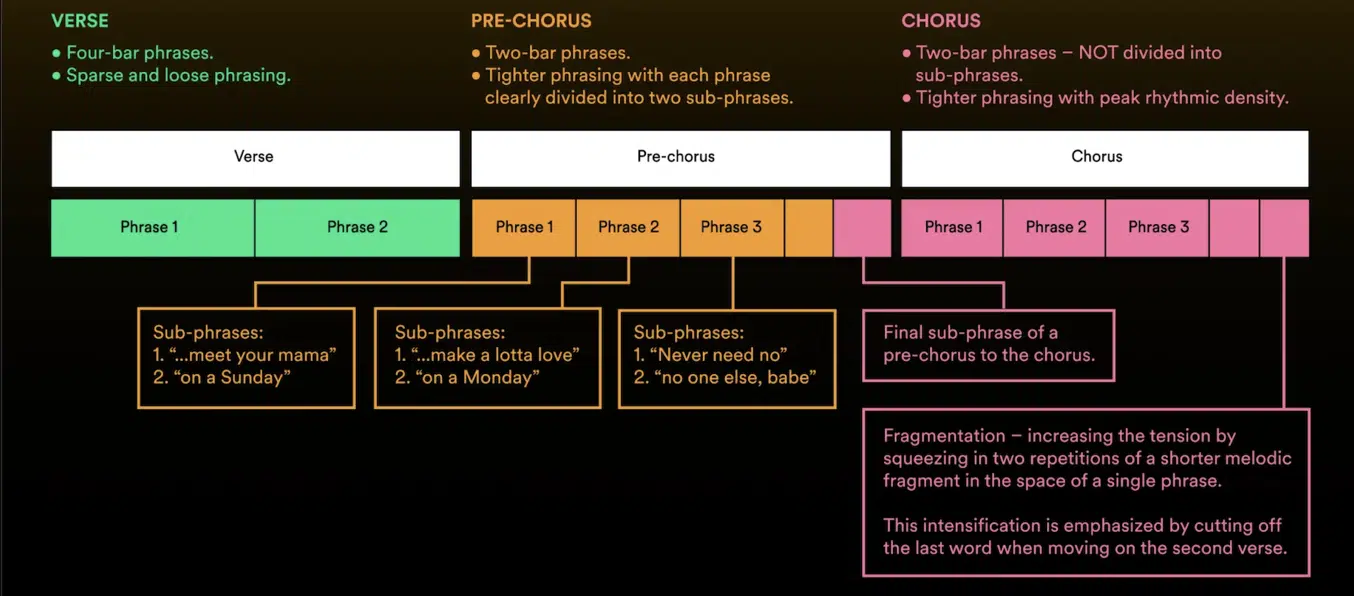If you’ve ever wondered about the difference between a hook and a chorus, or how to create them effectively, you’ve come to the right place.
In this comprehensive hook vs chorus guide, you’ll learn:
- The key differences between hooks & choruses ✓
- Different types of hooks/choruses and their roles in music ✓
- Examples of iconic hooks and choruses in popular music ✓
- Expert advice for creating addicting hooks & choruses ✓
With this information at your fingertips, you’ll be well-equipped to understand the nuances of hooks and choruses and apply these concepts to your own music production journey.
Let’s dive in and unravel the mysteries behind the age-old debate: hook vs chorus.
Table of Contents
- What is a Hook?
- Types of Hooks
- What Is a Chorus?
- Song Structure: The Chorus
- How To Craft a Memorable Chorus
- Hook Vs Chorus: Uncovering The Differences
- Expert Tips for Creating Hooks
- Perfecting your hook-writing skills
- Expert Tips for Creating Choruses
- Using Pre-Choruses to Build Tension & Anticipation
- Hook vs Chorus: Final Thoughts
What is a Hook?
A hook is a catchy, memorable element of a song that grabs the listener’s attention and keeps them engaged.
Hooks can take many forms, including melodies, rhythms, lyrics, and instrumental riffs.
Their primary purpose is to make the song stick in listeners’ minds and encourage them to hum or sing along.
Hooks play a crucial role in popular music, often making the difference between a basic song and a legendary one.
In some cases, hooks can even become synonymous with the whole song itself, as they’re instantly recognizable.
This is particularly true in the hip-hop and hip-hop subgenres, like Future’s “Mask Off” (above) where memorable hooks are essential for commercial success.
Hooks can be found throughout a song, not just in the chorus.
They can appear in the intro, verses, pre-chorus, or even the bridge, and can be repeated multiple times.
Conversely, they can be used more sparingly to create tension and dramatic effect.
The key to a successful hook is striking the right balance between repetition and variation, ensuring the hook remains fresh and engaging throughout the song.
A guitar riff, often an instrumental hook, can be the backbone of a song, driving its rhythm and providing a memorable melodic idea.
Similarly, a key lyric line can serve as a vocal hook, encapsulating the song’s message and sticking in the listener’s mind.
Sometimes, a song may rely on only one hook to keep the audience engaged, while other times, multiple hooks can be used throughout the composition.
For instance, consider Michael Jackson’s song “Billie Jean” – the bassline is instantly recognizable, while the vocal melody in the chorus serves as another captivating hook example.
Types of Hooks
There are several types of hooks you might encounter in music, including:
- Melodic Hooks 一 These are catchy melodies that get stuck in the listener’s head, often featuring a simple and easily singable tune. Melodic hooks can be found in vocal lines, instrumental riffs, or even as part of the main chord progression.
- Rhythmic Hooks 一 These hooks rely on a catchy rhythm or groove to capture the listener’s attention. Rhythmic hooks can be found in drum patterns, basslines, or even how a singer phrases their lyrics.
- Lyrical Hooks 一 Lyrical hooks are catchy phrases or lines that stand out in a song, often due to their clever wordplay, emotional resonance, or relatability. They can be a powerful way to connect with listeners on a deeper level, as well as make the song’s hook more memorable.
The Role of Hooks In Songwriting

Incorporating a great hook into your songwriting process can help elevate your music and make it more memorable/appealing to listeners.
Whether you’re working on the melody, rhythm, or lyric phrase, focusing on creating a strong hook can make your song truly shine.
When crafting good hooks, it’s essential to consider the target audience and genre.
Different types of hooks may be more effective in different genres or for different listeners.
Understanding what resonates with your intended audience is absolutely crucial.
Finally, don’t be afraid to iterate and refine your hooks during the songwriting process.
Great songs may not come together in the first draft, we’ve all been there.
However, with persistence and experimentation, you can create hooks that capture your audience’s attention and make your music unforgettable.
What Is a Chorus?
A chorus is the central, repeated section of a song that typically follows the verses and pre-chorus.
It often features the catchiest part of the melody, along with captivating lyrics that convey the main theme or message of the song.
In many cases, the chorus is the most memorable part of a song, as it is usually repeated multiple times throughout the track, reinforcing its impact.
Good choruses are designed to be memorable and emotionally powerful, aiming to connect with the listener on a deeper level.
They often contain the song’s main hook, which helps to create a sense of familiarity and catchiness.
A great example of a chorus is Snoop Dogg’s “Drop It Like It’s Hot” (shown above), which has a timeless chorus that everyone knows.
Whether they love it or hate it, they know it, and that’s the real goal when creating an addicting chorus.
It’s an essential component of a song and provides the emotional peak that keeps listeners engaged and coming back for more.
Catchy choruses can be the difference between a hit and a miss 一 making it a crucial aspect of songwriting for artists, producers, and musicians in general.
Remember, a well-crafted chorus doesn’t always rely solely on vocals or lyrics.
It can also include instrumental elements that contribute to a song’s overall appeal.
Song Structure: The Chorus

The chorus plays a crucial role in a song’s structure, serving as the focal point and emotional climax of the piece.
In addition to being catchy and memorable, a well-crafted chorus can help convey the song’s central message or theme.
This is what provides a sense of cohesion and unity within the song.
The chorus is typically placed after the verses and pre-chorus, though it can sometimes appear at other points in the song’s structure.
Also, it is usually repeated multiple times throughout the song, with the number of repetitions varying depending on the specific arrangement and style.
In many cases, the chorus will feature a variation or modulation in the final repetition.
This is done to add an extra layer of emotional impact and help to bring the song to a satisfying conclusion.
In terms of song structure, the chorus serves as a crucial ‘anchor’ point, providing a familiar and emotionally resonant section that listeners can latch onto.
A strong chorus can help to tie together the various elements of a song, ensuring that the overall composition feels engaging and fluid.
If you want to create unique music, knowing all about song structure is vital.
Think of the Ghostbusters theme song… I’m sure you can remember the chorus very well.
That’s because it’s a great example of an anchor point.
How To Craft a Memorable Chorus
Creating a memorable and impactful chorus is an essential skill for any musician.
To craft a chorus that resonates with listeners, consider the following tips:
- Keep It Simple 一 A great chorus is often simple and easily singable, allowing listeners to quickly pick up the melody and sing along. This simplicity can help to make the chorus more memorable and emotionally impactful.
- Focus On The Hook 一 As mentioned earlier, the chorus often contains the song’s main hook. Ensuring that this hook is strong and catchy can help to create a memorable chorus that sticks in the listener’s mind.
- Use Repetition 一 Repeating certain phrases or melodic elements within the chorus can help to reinforce its impact and make it more memorable. However, be mindful not to overdo repetition, as this can cause the chorus to become monotonous or predictable.
Make sure to focus on these elements and continuously refine your chorus-writing skills.
This way, you’ll be well on your way to crafting memorable and emotionally powerful choruses.
They’ll make your listeners feel connected, and they’ll elevate your music in a major way.
Hook Vs Chorus: Uncovering The Differences

While both hooks and choruses play a vital role in creating memorable songs, they serve distinct purposes within a track.
Hooks are designed to capture the listener’s attention and can appear throughout a song, including the intro, verses, and choruses.
They come in various forms, such as instrumental hooks, rhythm hooks, or vocal hooks, and can even consist of a catchy lyric line.
Choruses, on the other hand, are typically repeated sections that convey the main theme or message of a song.
They often feature the catchiest part of the melody and lyrics, making them the most memorable part of the song for most listeners.
In some cases, hooks and choruses may overlap, with the chorus containing a particularly catchy hook.
One significant difference between hooks and choruses is their placement and frequency within a song
Choruses are generally more structured and repetitive, appearing at specific points after the song’s verses or pre-choruses.
Hooks, however, can be scattered throughout a song, sometimes even functioning as the intro or the basis for the entire composition.
Speaking of compositions, if you need a quick refresher course on Music Theory, we’ve got you covered.
Hook vs Chorus: Summing It Up
Hooks are designed to capture the listener’s attention and can appear throughout a song in various forms.
Choruses are typically repeated sections that convey the main theme or message of a song, often featuring the catchiest part of the melody and lyrics.
- Choruses 一 Usually follow a more structured and repetitive format.
- Hooks 一 Can be scattered throughout a song and take on many different forms.
Understanding the differences between these two vital elements will help you create legendary, addicting songs that your listeners can’t forget.
Expert Tips for Creating Hooks

Developing your own unique style for creating hooks can set you apart in the music industry (or the underground scene).
Experiment with various melodic ideas, rhythms, and instrumentations to find what resonates with you and your target audience.
Keep in mind that some of the best hooks are super simple, making it easy for listeners to get them stuck in their heads.
To create your own hook style, consider the following:
- Analyze popular songs in your genre to identify common hook techniques and trends.
- Experiment with different instruments, sounds, and textures to find your signature sound.
- Practice writing short musical phrases and melodies, focusing on simplicity and memorability.
Using Hooks to enhance song structure
Incorporating hooks strategically throughout your song can enhance its overall structure, making it more engaging and memorable for listeners.
For example, you might start a good song with an intro hook to capture the listener’s attention immediately.
You could also use instrumental hooks or rhythm hooks during verses or bridge sections to maintain interest and create additional hooks for listeners to get excited about.
Perfecting your hook-writing skills
Like any other skill, writing great hooks takes practice and patience.
To improve your hook-writing abilities, consider collaborating with other musicians, songwriters, or producers to gain fresh perspectives and ideas.
Additionally, listening to and analyzing a wide range of music from different genres can provide valuable insights into what makes a hook effective and memorable.
Not all hooks are catchy, but I’m sure you can even think of a few songs right now that truly stand out in your head.
Chances are, they probably have an unforgettable hook that your brain just can’t let go of.
The only hook you need to worry about creating is a super memorable one.
Expert Tips for Creating Choruses

A strong chorus can elevate a song from good to great, so it’s essential to dedicate time and effort to crafting choruses that resonate with listeners.
Focus on writing a memorable melody and compelling lyrics that convey the emotional core of the song.
Additionally, experiment with different chord progressions, rhythms, and vocal harmonies to find the perfect combination that complements the rest of your song.
- Focus on creating a catchy melody that is easy for listeners to sing along to.
- Write lyrics that convey the main theme or message of the song.
- Experiment with different chord progressions, rhythms, and vocal harmonies.
Using Pre-Choruses to Build Tension & Anticipation

Incorporating a pre-chorus into your song can help build tension and anticipation, setting the stage for the chorus to shine.
A pre-chorus often features a different melody and chord progression than the verse and chorus, creating a sense of contrast that keeps the listener intrigued.
By crafting a pre-chorus that builds momentum and seamlessly transitions into the chorus, you can create a more dynamic and engaging song structure.
To effectively use pre-choruses, try the following:
- Write a pre-chorus that contrasts with the verse and chorus in terms of melody and chord progression.
- Use the pre-chorus to build tension and anticipation, leading into the chorus.
- Ensure the transition between the pre-chorus and chorus is smooth and seamless.
Hook vs Chorus: Final Thoughts
Now that you’re well-versed in the world of hooks and choruses, it’s time to put your newfound knowledge to the test and start creating your own unforgettable songs.
Remember, an engaging hook and a powerful chorus can be the difference between a song that listeners can’t get enough of and one that fades into obscurity.
By combining memorable melodies, captivating lyrics, and unique instrumental elements, you’ll be well on your way to creating music that resonates with your audience.
To help you in your quest for crafting the perfect hooks and choruses, you’ll need the absolute best chord pack available today: the Unison MIDI Chord Pack.
This comprehensive toolkit is designed to simplify the process of creating captivating chord progressions and melodies that can serve as the foundation for your hooks and choruses.
With over 1,200 mind-blowing MIDI files, this pack will undoubtedly spark your creativity and help you elevate your songwriting skills to new heights.
With dedication and a strong understanding of hooks and choruses, you’re well on your way to leaving a lasting impact in the world of music.
Until next time…






